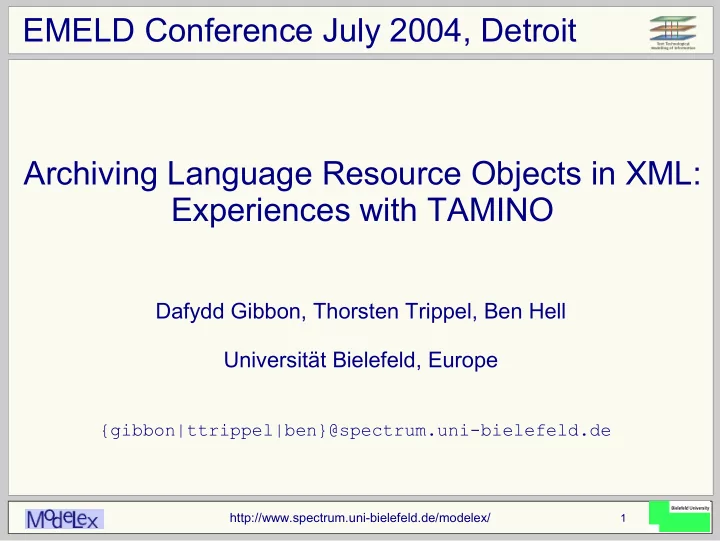

EMELD Conference July 2004, Detroit Archiving Language Resource Objects in XML: Experiences with TAMINO Dafydd Gibbon, Thorsten Trippel, Ben Hell Universität Bielefeld, Europe {gibbon|ttrippel|ben}@spectrum.uni-bielefeld.de http://www.spectrum.uni-bielefeld.de/modelex/ 1
Overview ● Archiving in XML ● Language Resources ● Getting abstract: types of Resource Object ● Abstract Resource Object implementation in XML ● Getting Practical: the ModeLex application ● Using an XML database: TAMINO Procedure - Database creation - Corpus data stored in the file system - Using a DBMS for storing Resource Objects - Selected use cases - Querying - Signal processing ● Conclusion: evaluation and further work http://www.spectrum.uni-bielefeld.de/modelex/ 2
Archiving in XML Background: projects Ega (2001) ModeLex (2001-...) ABUILD (2002-...) LLSTI (2003-...) Goal: specifying a DBMS for Resource Object storage Resource Objects: General Resource Object (GRO, linguistic data type) Specific Resource Object (SRO, instance of GRO) Abstract Resource Object (ARO, abstract data structure) Implementational Resource Object (IRO, PL/KRL data structure) http://www.spectrum.uni-bielefeld.de/modelex/ 3
Language Resources Written texts, dialogue transcriptions Annotations time-stamped transcription marked up written text & transcription Signal recordings audio, video, laryngograph (electroglottograph), airflow, ... Lexical information Multimodal resource search: structuring with XML storing accessing updating http://www.spectrum.uni-bielefeld.de/modelex/ 4
Getting abstract: types of Resource Object General Resource Object (GRO, linguistic data type) Specific Resource Object (SRO, instance of GRO) Abstract Resource Object (ARO, abstract data structure) strings - string sequences - structures over strings - lists - tables - DAGs - CGs - numbers - ... Implementational Resource Object (IRO, PL/KL data structure) TREES: typically for constituent structures and taxonomies TABLES: typically for lexica and paradigm tables DAGs: typically for (almost) anything ☺ http://www.spectrum.uni-bielefeld.de/modelex/ 5
Abstract Resource Objects and XML IROs XML abstract syntax defined as recursive ternary relation... OBJECT = string OBJECT = {x: x = <typename, AVS, OBJECT + >} ... can only define tree structures: a n b n (Type 2, CF L) Not defined in XML syntax: For embedded tables further constraints necessary... ... general indexing needed: a n b n c n (Type 1, CS L subset) For general graphs, networks, semantic extension needed: pointer structures permit extension beyond tree structures. Thus: access tools must be more powerful than XML syntax requires. http://www.spectrum.uni-bielefeld.de/modelex/ 6
Getting practical: the ModeLex application Corpus layers and metadata layers: Search application: Subcorpus Typisation Segment in Signal in Annotation layer (Metadata) context context Annotation segment http://www.spectrum.uni-bielefeld.de/modelex/ 7
Preliminaries: XML format normalisation Corpus format: depends on application (WAV; praat, esps-waves+, TASX, ...) Normalization: XML format Preservation of all bits of information from source metadata timestamps technical information Time Aligned Signal eXchange format (TASX) Grammar normalization: DTD to XSchema conversion http://www.spectrum.uni-bielefeld.de/modelex/ 8
Use case: Multimodal concordance Functional requirements specification: Input: <searchkey, <recording, annotation>> Output: subset of <recording, anotation> - matching search key + context-tier - corresponding to output format filters (tiers, length, signal transformation) http://www.spectrum.uni-bielefeld.de/modelex/ 9
Design: signal concordance http://www.spectrum.uni-bielefeld.de/modelex/ 10
Implementation: TAMINO XML DBMS - 1 Options: 1. data on file system: command line access easy to manipulate selection complex performance with large repositories 2. storage in TAMINO create DB (Tamino Software Management Hub) create "collection" (Tamino: Schema Editor) insert schema (Tamino: Schema Editor) insert document instances (Tamino: Schema Editor, Tamino Interactive Interface,...) http://www.spectrum.uni-bielefeld.de/modelex/ 11
Implementation: TAMINO XML DBMS - 2 Traditional tools: file system + ad hoc tools XML command technologies: filesystem based XQuery saxon XQuery tool /Java Library exquisit: GUI for saxon Tamino based tools: Tamino interactive interface, webinterface Tamino XQuery (Windows Application) Tamino Java API Perl API: any Perl program, e.g. browser based GUIs http://www.spectrum.uni-bielefeld.de/modelex/ 12
Implementation: TAMINO XML DBMS - 3 Access: based on XQuery unit selection using metadata AND annotation segment key context selection on same tier OR parallel tiers based on time interval → XQuery arithmetic in Tamino sibling access → available in saxon, not in Tamino http://www.spectrum.uni-bielefeld.de/modelex/ 13
Implementation: TAMINO XML DBMS - 4 Audio: Selected interval based on time stamps Further analysis possible if lossless compression files: spectrogram, oscillogram, formant analysis, ... Fast (almost real time): praat scripting + sox Gibbon and Trippel 2001: Portable Audio Concordance System. TR-UBI Video: Audio in principle as above Granularity: frame based, not sample-based technical restrictions: keyframe rate Time consuming: no real time processing http://www.spectrum.uni-bielefeld.de/modelex/ 14
Conclusion: evaluation and further work Summary: Proof of concept for TASX audio corpus Tamino, Perl Audio signal processing: PAX modules, based on Praat XQuery selection: corpus - subcorpus - layer - segment To do: GUI not fail-safe (fails if metadata incomplete) Inconsistency potential in file storage of signal recordings Optimisation of XQuery vs. XSLT for formatting http://www.spectrum.uni-bielefeld.de/modelex/implementation/concordance.html http://www.spectrum.uni-bielefeld.de/modelex/ 15
Recommend
More recommend